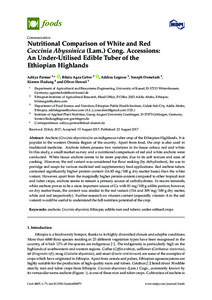| dc.date.accessioned | 2018-02-01T15:21:29Z | |
| dc.date.available | 2018-02-01T15:21:29Z | |
| dc.date.issued | 2017-08-22 | |
| dc.identifier.issn | 2304-8158 | |
| dc.identifier.uri | urn:nbn:de:hebis:34-2018020154312 | |
| dc.identifier.uri | http://hdl.handle.net/123456789/2018020154312 | |
| dc.description.sponsorship | Gefördert durch den Publikationsfonds der Universität Kassel | |
| dc.language.iso | eng | |
| dc.rights | Urheberrechtlich geschützt | |
| dc.rights.uri | https://rightsstatements.org/page/InC/1.0/ | |
| dc.subject | anchote | eng |
| dc.subject | Coccinia abyssinia | eng |
| dc.subject | Ethiopia | eng |
| dc.subject | edible root and tubers | eng |
| dc.subject | under-utilised crops | eng |
| dc.subject.ddc | 630 | |
| dc.title | Nutritional Comparison of White and Red Coccinia Abyssinica (Lam.) Cong. Accessions: An Under-Utilised Edible Tuber of the Ethiopian Highlands | eng |
| dc.type | Aufsatz | |
| dcterms.abstract | Anchote (Coccinia abyssinica) is an indigenous tuber crop of the Ethiopian Highlands. It is popular in the western Oromia Region of the country. Apart from food, the crop is also used in traditional medicine. Anchote tubers possess two variations in its tissue colour, red and white. In this study, a small market survey and a nutritional comparison of red and white anchote were conducted. White tissue anchote seems to be more popular, due to its soft texture and ease of cooking. However, the red variant was considered for flour making (by dehydration), for use in porridge and soups for various medicinal and supplementary food applications. Red anchote tubers contained significantly higher protein content (16.85 mg/100 g dry matter basis) than the white variant. However, apart from the marginally higher protein content compared to other tropical root and tuber crops, anchote seems to remain a primary source of carbohydrates. In macro minerals, white anchote proves to be a more important source of Ca with 81 mg/100 g edible portion; however, on dry matter basis, the content was similar to the red variant (316 and 309 mg/100 g dry matter, white and red respectively). Further research on vitamin content (especially vitamin A in the red variant) would be useful to understand the full nutrition potential of the crop. | eng |
| dcterms.accessRights | open access | |
| dcterms.bibliographicCitation | In: Foods. - Basel : MDPI. - 2017, 6(8), 71, 1-8 | |
| dcterms.creator | Parmar, Aditya | |
| dcterms.creator | Gebre, Bilatu Agza | |
| dcterms.creator | Legesse, Addisu | |
| dcterms.creator | Demelash, Yoseph | |
| dcterms.creator | Fladung, Kirsten | |
| dcterms.creator | Hensel, Oliver | |
| dc.relation.doi | doi:10.3390/foods6080071 | |

